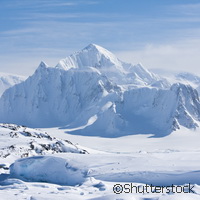Antarctica's feeling a bit gassy
Methane, a chemical compound, is a colourless, odourless gas. Despite its many uses, it is a relatively potent greenhouse gas. New research published in Nature and conducted by an international team from the University of Bristol (United Kingdom), the University of California, Santa Cruz (United States), the University of Alberta, Edmonton (Canada) and the University of Utrecht (the Netherlands) shows that the Antarctic Ice Sheet could be an overlooked but important source of methane. The new study led by Professor Jemma Wadham from the University of Bristol's School of Geographical Sciences essentially demonstrates that old organic matter in sedimentary basins located beneath the Antarctic Ice Sheet may have been converted to methane by microorganisms living under oxygen-deprived conditions. All this methane is trapped in the ice sheet; however, all this methane could escape into the atmosphere if the ice sheet shrinks and exposes these old sedimentary basins. The researchers estimate that 50 % of the West Antarctic Ice Sheet (1 million km2) and 25 % of the East Antarctic Ice Sheet (2.5 million km2) overlie pre-glacial sedimentary basins, containing about 21,000 billion tonnes of organic carbon. According to the team's leader, Professor Wadham, 'This is an immense amount of organic carbon, more than 10 times the size of carbon stocks in northern permafrost regions. Our laboratory experiments tell us that these sub-ice environments are also biologically active, meaning that this organic carbon is probably being metabolised to carbon dioxide and methane gas by microbes.' The researchers focused their efforts and simulated the accumulation of methane in the sedimentary basins of the Antarctic using an established one-dimensional hydrate model. Using this model they discovered that sub-ice conditions favour the accumulation of methane hydrate (that is, methane trapped within a structure of water molecules, forming a solid similar to regular ice). They were also able to calculate that the potential amount of methane hydrate and free methane gas beneath the Antarctic Ice Sheet could be up to 400 billion tonnes (that is, 400 Pg of carbon), a similar order of magnitude to some estimates made for Arctic permafrost. What is also alarming is that the predicted shallow depth of these potential reserves also makes them more susceptible to climate forcing - the initial drivers of a climate shift - than other methane hydrate reserves on Earth. Dr Sandra Arndt, a Natural Environment Research Council (NERC) fellow at the University of Bristol who conducted the numerical modelling, was not too surprised by the findings. 'It's not surprising that you might expect to find significant amounts of methane hydrate trapped beneath the ice sheet. Just like in sub-seafloor sediments, it is cold and pressures are high which are important conditions for methane hydrate formation.' If substantial methane hydrate and gas are present beneath the Antarctic Ice Sheet, methane release during episodes of ice sheet collapse could act as a positive feedback on global climate change during past and future ice sheet retreat. Professor Slawek Tulaczyk, glaciologist from the University of California, Santa Cruz, believes that their findings have far-reaching implications and deserve further attention so that they can be fully understood. 'Our study highlights the need for continued scientific exploration of remote sub-ice environments in Antarctica, because they may have far greater impact on Earth's climate system than we have appreciated in the past.'For more information, please visit: University of Bristol School of Geographical Scienceshttp://www.bristol.ac.uk/geography/European Union - Environment http://ec.europa.eu/environment/enveco/climate_change/index.htm(opens in new window)
Countries
Canada, United Kingdom, United States



